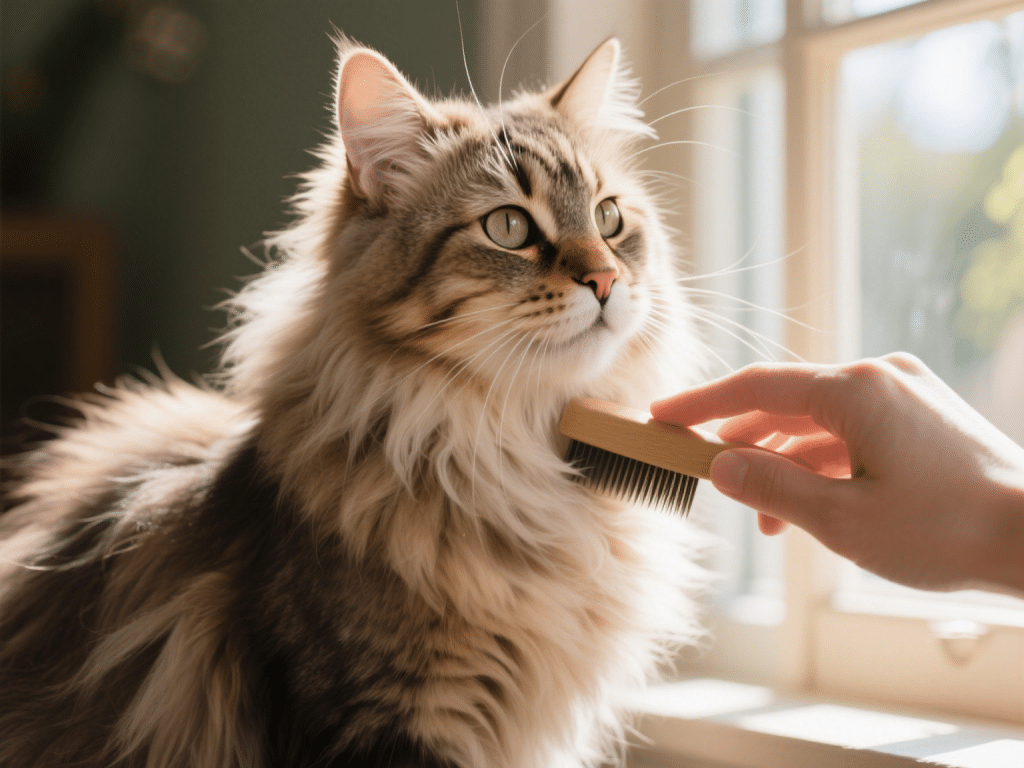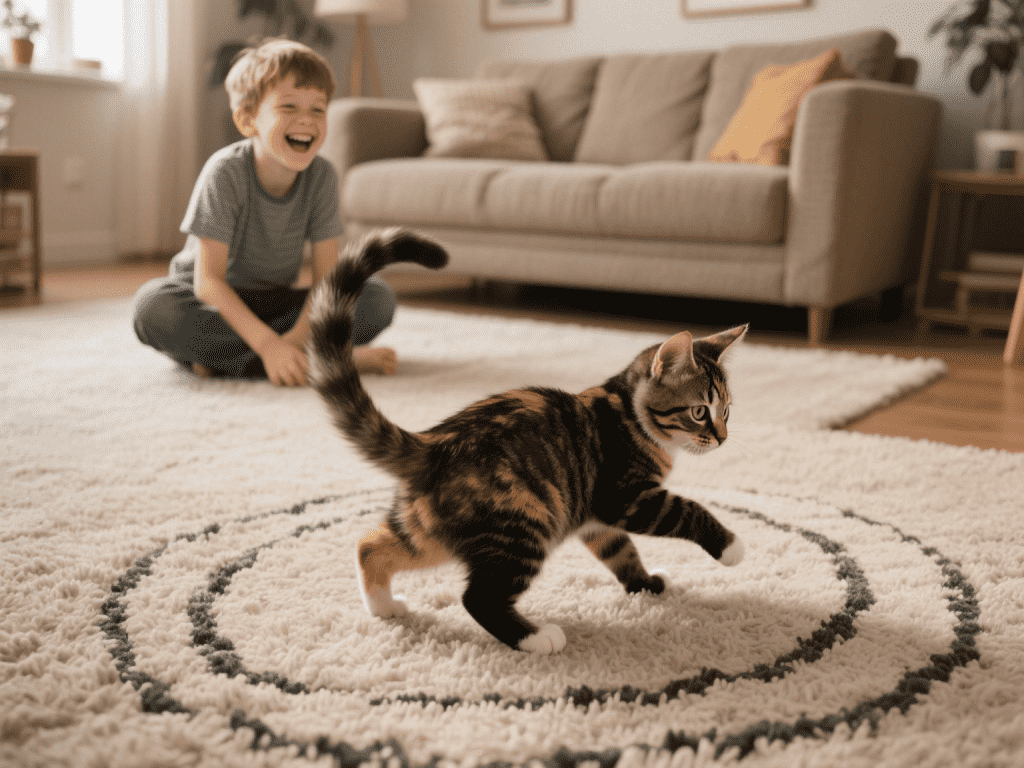Introduction
Cats communicate through a range of subtle and overt behaviors that often confuse even experienced pet owners. By learning to decode these signals, you can strengthen your bond, reduce stress for both you and your feline companion, and create a well-balanced household. This article outlines common cat behaviors, explains their underlying motivations, and offers practical, expert-backed strategies to address each one.
1. Scratching Furniture and Carpets
Why They Scratch
Territory Marking: Cats have scent glands in their paws and scratch to leave both visual and olfactory markers.
Nail Maintenance: Scratching helps cats shed old nail sheaths and keep their claws sharp.
Stretching & Exercise: It provides a full-body stretch, engaging muscles along the back and shoulders.
How to Address It
Provide Appropriate Alternatives: Place horizontal and vertical scratching posts or pads in high-traffic areas. Choose sisal or corrugated cardboard textures that mimic natural surfaces.
Positive Reinforcement: Whenever the cat uses a designated scratching area, offer praise or a small treat.
Deterrence: Gently redirect the cat from prohibited surfaces to approved posts. Use double-sided tape or a thin plastic cover on furniture legs to discourage scratching.
Regular Nail Trimming: Trim your cat’s nails every 2–3 weeks to reduce the damage caused by scratching. If uncomfortable doing it yourself, consult a professional groomer.
2. Excessive Meowing or Vocalization
Why They Vocalize
Attention Seeking: Cats may meow to request playtime, petting, or feeding.
Stress or Anxiety: Loud meowing can indicate discomfort, stress, or confusion—especially after environmental changes.
Medical Issues: Pain, hyperthyroidism, or cognitive dysfunction in senior cats can manifest as increased vocalization.
How to Address It
Rule Out Medical Causes: If vocalization is sudden or accompanied by other symptoms (e.g., weight loss, lethargy), visit a veterinarian promptly.
Establish a Routine: Feed and play at consistent times to reduce uncertainty and attention-seeking calls.
Interactive Play Sessions: Daily, focused play (using wand toys or laser pointers) can redirect excess energy and reduce boredom-induced meowing.
Ignore Attention-Seeking Meows: Only respond when the cat is calm; rewarding loud meows inadvertently reinforces the behavior.
3. Kneading (“Making Biscuits”)
Why They Knead
Kitten Reflex: Kneading originates from nursing; kittens knead the mother’s belly to stimulate milk flow.
Comfort & Affection: In adulthood, cats knead to show contentment and bond with a trusted human or soft surface.
Territory Marking: Paw pads secrete pheromones, and kneading marks safe or comforting areas.
How to Address It
Provide Soft Blankets or Bedding: Allow your cat to knead on designated fabric items. Replace items if they become too worn or soiled.
Trim Nails Regularly: Reducing sharpness minimizes potential scratches when kneading on your lap.
Redirect to a Pillow or Toy: If your cat kneads directly on you and the claws are intrusive, gently slide a pillow between you and your cat’s paws.
4. Litter Box Aversion
Why They Avoid the Litter Box
Dirty Litter: Cats are fastidious. A soiled box can deter use.
Box Location: A noisy or high-traffic area might make cats feel vulnerable.
Medical Conditions: Urinary tract infections, kidney disease, or arthritis can make litter box use painful.
How to Address It
Maintain Spotless Conditions: Scoop clumps daily and fully change litter at least once weekly. Use unscented, clumping clay or natural litters, as some cats dislike fragrances.
Optimal Placement: Choose a quiet, private location away from loud appliances. Ensure the box is easily accessible, especially for senior or arthritic cats.
Provide Enough Boxes: The rule of thumb is one box per cat, plus one extra. If you have two cats, offer at least three boxes.
Monitor Medical Health: If your cat suddenly stops using the box, seek veterinary advice to exclude underlying health issues.
5. Aggression Toward Family Members or Other Pets
Types of Aggression
Redirected Aggression: Triggered by an external stimulus (e.g., seeing another cat through a window), then directed toward a nearby person or pet.
Territorial/Inter-cat Aggression: Cats may fight over resources, territory, or social rank.
Petting-Induced Aggression: Caused by overstimulation or sensitivity during petting sessions.
How to Address It
Identify Triggers: Carefully observe what precedes aggressive episodes. Keep a log to spot patterns (e.g., times of day, presence of other animals).
Environmental Enrichment: Increase vertical territory—install cat shelves or perches—so each cat has its own space. Offer toys, interactive feeders, and hiding places.
Gradual Reintroduction: For a new cat, keep them in a separate room initially. Exchange bedding between cats to familiarize scents, then allow supervised visual contact through a cracked door or baby gate.
Behavioral Modification: Use interactive play to burn off excess energy. If aggression is redirected, calmly remove the cat from the situation and redirect focus using a toy. Reward calm behavior.
Consult a Certified Behaviorist: If aggression persists or escalates, seek professional help to design a tailored behavior modification plan.
6. Overgrooming and Hair Loss
Why They Overgroom
Stress or Anxiety: Changes in routine, loss of a companion, or environmental stressors can lead to excessive grooming.
Parasites or Skin Infections: Fleas, mites, or fungal infections such as ringworm cause itching and discomfort.
Allergies: Food, environmental allergens (pollen, dust mites), or flea saliva can trigger allergic dermatitis.
Underlying Pain: Arthritic pain or dental issues sometimes manifest as overgrooming in unrelated areas.
How to Address It
Veterinary Examination: Rule out parasites, infections, or allergies. Skin scrapings, allergy tests, or bloodwork might be necessary.
Reduce Environmental Stress: Provide hiding spots, consistent routines, and pheromone diffusers (e.g., Feliway) to ease anxiety.
Use Elizabethan Collars or Recovery Suits: Temporarily prevent self-inflicted wounds while the underlying cause is treated.
Implement Anti-parasitic Treatments: Use vet-approved flea and tick preventatives. Vacuum the home thoroughly and wash bedding weekly.
Dietary Adjustments: For food allergies, transition to hypoallergenic or limited-ingredient diets under veterinary supervision.
7. Nighttime Activity and Excessive Play
Why They Are Nocturnal
Crepuscular Nature: Cats instinctively hunt at dawn and dusk.
Boredom or Pent-Up Energy: Indoor cats without sufficient stimulation may become active at night.
Disrupted Sleep Cycle: Changes in household schedule can shift their active hours.
How to Address It
Increase Daytime Activity: Schedule interactive play sessions in the morning and early evening to tire them out before bedtime. Use puzzle toys or food-dispensing toys during the day to engage their foraging instincts.
Set a Consistent Sleep Routine: Feed a small meal right before your bedtime; cats often nap after eating. Turn off lights and avoid interactive play during the night.
Provide Enriching Environment: Install cat trees, window perches, and scratching posts to allow safe exploration when you’re asleep.
Ignore Nighttime Disturbances: If the cat wakes you, avoid giving attention. Over time, they learn that nighttime activity won’t get a reaction.
Conclusion
Understanding and addressing common feline behaviors requires patience, observation, and consistency. By providing proper outlets for natural instincts—scratching, hunting, grooming—and ensuring a stress-free environment, you’ll foster a happy, well-adjusted cat. Always rule out medical issues first, and consult professionals when needed. With these strategies, you’ll build a stronger, more harmonious relationship with your feline friend.










Comments on " Understanding Common Cat Behaviors and How to Address Them" :